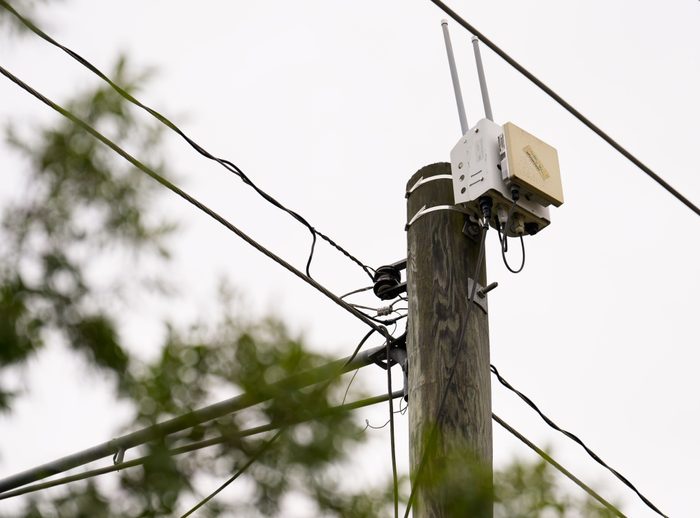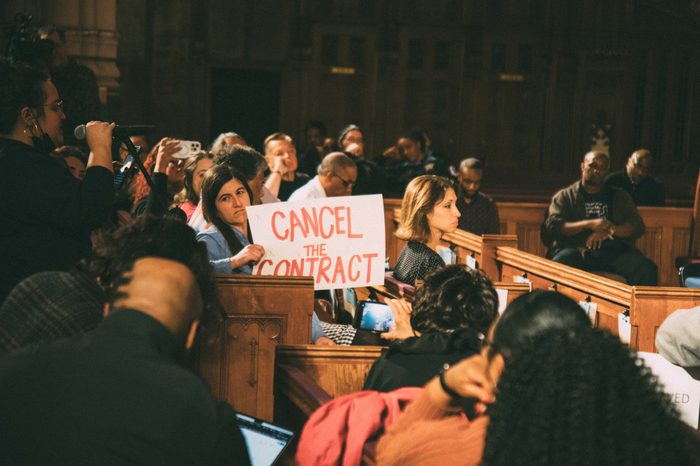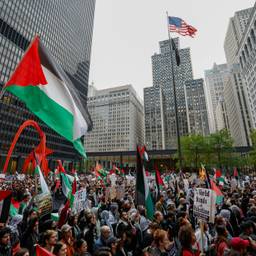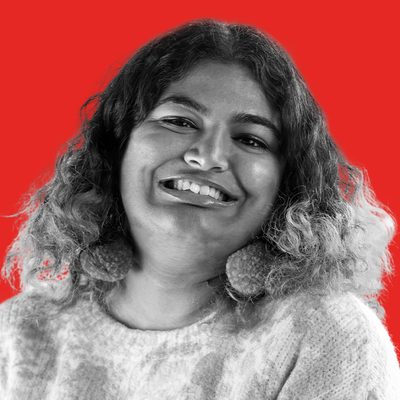Brandon Johnson Drops ShotSpotter
By fulfilling a campaign promise to end the contract with ShotSpotter, Johnson makes Chicago the largest city to cut ties with the controversial gunshot-detection company. The program could be finished as early as the end of this week.
Siri Chilukuri

CHICAGO — In line with one of his key campaign promises, Mayor Brandon Johnson this week canceled Chicago’s multi-million-dollar contract for ShotSpotter, the controversial, unreliable and otherwise flawed gunshot-detection technology.
“Moving forward, the city of Chicago will deploy its resources on the most effective strategies and tactics proven to accelerate the current downward trend in violent crime,” Johnson said in a news release.
His decision comes on the heels of years of sustained organizing by activists who say the software is ineffective and leads to over-policing and increased surveillance of Black and brown communities. While campaigning for mayor last year, Johnson called the technology “unreliable and overly susceptible to human error” and vowed to stop paying for it.
Some aldermen criticized Johnson’s decision on Tuesday and argued that ShotSpotter keeps residents safe by helping police respond faster to shootings.
ShotSpotter (recently renamed SoundThinking) says its sensors listen for gunshot sounds and then alert police to where the shootings occur. The sensors are in 12 of the city’s 22 police districts, the majority of which are located on the predominantly Black and brown South and West Sides. The Chicago Police Department first installed sensors in 2012, and in 2018, then mayor Rahm Emanuel signed a $33 million contract to expand its use. Lori Lightfoot, who was mayor after Emanuel, also extended the contract twice.

A campaign called Stop ShotSpotter emerged in 2021 when organizers across the country built coalitions designed around defunding police in the aftermath of the police killing of George Floyd in Minneapolis. The group has demanded that cities end their contracts with ShotSpotter and fund community-led solutions to violence.
“[The George Floyd protests were] an aha moment and also became such a strong entry point for conversations around corporate profits and law enforcement,” says Alyx Goodwin, an early member of the campaign who now serves as senior policy advisor in the Mayor’s Office of Community Safety.
In a statement posted on X (formerly Twitter), Stop ShotSpotter campaign organizers said, “This decision is an unprecedented one which wasn’t possible before Mayor Johnson, but we will continue to organize until all of ShotSpotter’s microphones are removed from Chicago.” The statement also described the decision as “imperfect” because organizers had demanded the city stop using ShotSpotter on February 16, when the contract expires, though it appeared the sensors might not be decommissioned until September, after the Democratic National Convention in Chicago.
But according to ABC7, the use of ShotSpotter may end quite rapidly — even as soon as the end of this week — as ShotSpotter representatives reportedly told “multiple City Council members” that they’re not interested in operating any further and will take their sensors and go home.
Almost a year after the uprisings related to George Floyd, just as campaign organizers were gearing up to release a report on ShotSpotter and other law enforcement surveillance technology, 13-year-old Adam Toledo was killed by Chicago police responding to a ShotSpotter alert. When police officer Eric Stillman arrived at the scene, Toledo ran away. Stillman pursued Toledo down an alley before shooting him in the chest.
That was the first time José Manuel Almanza, an organizer with Stop ShotSpotter and Únete La Villita, an affordable housing advocacy group, says he heard of ShotSpotter.
“[Toledo’s killing] prompted myself and other organizers and advocates to ask the question, ‘Well, what is ShotSpotter?’ Like, no one’s ever heard of it,” says Almanza. “And so that’s kind of what started the campaign to figure out what this technology is, how long have we been using it, who’s paying for it.”

As part of his Stop ShotSpotter campaign work, Almanza has been surveying the community and talking to neighbors about the technology. He says gun violence is top of mind for many residents.
ShotSpotter has received criticism from multiple directions as researchers, advocates and journalists dispute its efficacy as a gun-violence-reduction tool.
A 2021 study from Northwestern University’s MacArthur Justice Center found that nearly 90% of alerts led to no evidence of a gun-related crime and more than 85% led to no evidence of any crime at all over an approximately two-year period. The study also found a link between police responses to ShotSpotter alerts and unconstitutional stop-and-frisk and false arrests. Chicago’s Office of Inspector General reported that only 9% of ShotSpotter alerts led to evidence of a gun-related crime. And the company’s own documents admit that the software could mistake fireworks for gunshots.
“The overwhelming majority of ShotSpotter alerts turn up nothing,” reads a February open letter from the Stop ShotSpotter campaign to Johnson, “and every ShotSpotter alert puts Black and brown residents at risk of a dangerous encounter with police.”
Data should help guide decisions about how the city’s public safety budget is spent, says Charlie Ransford, senior director of science and policy and interim director of communications at Cure Violence, an anti-violence organization with a public-health approach.
“We have to look very carefully at where we are investing money to make sure that we’re investing it in the approaches that are most effective in reducing violence,” says Ransford. “If ShotSpotter is reducing violence, then we need to see that data; I’ve never seen data to show that ShotSpotter reduces violence.”
A recent South Side Weekly investigation by Jim Daley and Max Blaisdell reported that the service failed to detect more than 550 shootings in 2023 and a 55-round shooting in 2022. In the latter case, the ShotSpotter sensors nearby were out of service, according to emails obtained by the Weekly.
An internal document from the Cook County State’s Attorney’s Office, the county department that prosecutes cases in Chicago and the surrounding suburbs, found that the expensive tool had little effect on prosecuting gun violence cases.
“ShotSpotter does not address known shooting incidents in Chicago,” reads the document. According to the office’s review, ShotSpotter alerts led to arrests in only 1% of more than 12,000 incidents in a five-year period.
In a statement sent to In These Times, ShotSpotter defended the technology and its usefulness to law enforcement and residents: “In the time that it has been deployed in Chicago, ShotSpotter has led police to locate hundreds of gunshot wound victims where there was no corresponding call to 911. Those are victims who most likely would not have received aid — if not for ShotSpotter,” said Ralph Clark, CEO of the company.
The Mayor’s Office did not respond to requests for comment.
Last week, a citywide public safety commission called a community meeting to discuss the contract’s fate after receiving pressure from activists, including organizers with the Stop ShotSpotter campaign. The meeting, which took place in St. Sabina Church on the South Side, quickly grew tense. Public commenters stood between rows of pews to speak — sometimes through tears — going back and forth on whether the city should continue using ShotSpotter.
“We are very underserved,” said Marlin Howell, who has lived in Chicago’s Greater Grand Crossing neighborhood for more than 50 years. “We need all the help we can get with technology because people today are not [calling 911] or getting involved.”
Others called for an end to ShotSpotter and asked for more community-led solutions to crime.
“I’m urging the mayor to cancel the ShotSpotter contract. Solutions to gun violence must come from affected communities, not police or companies that profit off of and rely on violence to justify their existence,” said Katherine Shaw, an organizer and teacher in Chicago.
By the end, the meeting devolved into a shouting match between organizers and Anthony Driver, president of the public safety commission.
Leonardo Quintero, a member of Chicago’s newly created police district councils, later walked up to a microphone, turned to face the crowd and announced, “Me and my fellow [district council members] are going to be walking out because this has turned into copaganda.”
The room became so unruly that Driver reluctantly interrupted another commissioner to attempt to end the meeting after several outbursts.
“This issue is not as binary as you are making it,” Driver yelled through a microphone as more people left the church. Those who stayed continued to shout.
Now that the contract is ending, the city will work with law enforcement and community groups during the next seven months to come up with recommendations for alternative public safety tools and programs, according to the Mayor’s Office’s news release.
As the city considers if and how other tools could be useful or effective, Goodwin wants organizers to keep pushing for better public safety solutions.
“I just see tremendous opportunity to build on the Stop ShotSpotter campaign for continued conversations around transparency, accountability, our own input on public safety, as it relates to policing and technology, and how much we are spending as a city on these tools,” says Goodwin.
Damayanti Wallace, co-founder of GoodKids MadCity (GKMC), a youth-led anti-violence organization, wants to see the energy of this campaign continue by advocating for reinvestments in the same communities that experience high rates of gun violence.

“We know that if our neighborhoods have the right tools and resources like the Peace Book,” says Wallace, “we can make our spaces safer without having surveillance systems and cops.”
GKMC has been pushing for an ordinance called the Peace Book for several years now and collaborated with aldermen in 2022 to introduce it in City Council, but it failed to pass. The ordinance would divert money away from the police department budget to fund community-led violence prevention programs.
Community-led legislation like the Peace Book, along with others such as the Bring Chicago Home and Treatment Not Trauma, are designed to target the root causes of poverty. Johnson promised to implement these initiatives during his campaign, and several have undergone unprecedented progress in recent months.
Last fall, a City Council ordinance passed that brought Chicago closer to implementing Treatment Not Trauma, a community proposal to expand non-police responses to mental health services. And despite pushback from real estate groups, the Bring Chicago Home referendum — which would raise the real estate transfer tax on homes worth more than $1 million to combat homelessness — is expected to appear on the March 19 primary ballot.
“The safest neighborhoods in Chicago don’t have ShotSpotter,” says Kennedy Bartley, executive director of United Working Families, a progressive organization in Chicago that played a pivotal role in Johnson’s election. “They have good schools, they have good jobs. They have homes. And that’s what we believe that all 77 community areas in Chicago deserve.”
Siri Chilukuri is a freelance journalist and environmental justice fellow with Grist. She covers climate change, local politics, labor and culture. You can follow her on Twitter (X) @schilukuri1.







